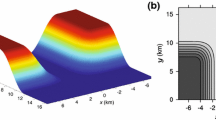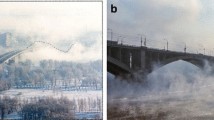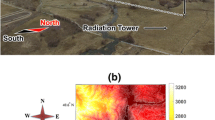Summary
The local wind system in the upper Isar Valley (Bavarian Alps) near Mittenwald has the peculiarity that regularly strong foehn-like nocturnal flows occur, mainly during clear nights in autumn and winter. We will refer to this phenomenon as “Minifoehn”, as its properties are similar to the classical deep foehn in the sense that its breakthrough into the Isar Valley usually brings a striking increase in temperature and a concomitant decrease in relative humidity. Numerical simulations with the MM5 model reveal that this phenomenon is related to a nocturnal drainage flow originating from a plateau south of Mittenwald. This flow is driven by the temperature difference between this plateau (1180 m) and the free atmosphere above Mittenwald (920 m, 15 km north of the plateau) at the same level. The air masses flow through two different valleys that merge again further downstream. The upper part of one of the two drainage currents goes over a small mountain ridge (1180 m) south-west of Mittenwald and then descends into the Isar Valley, leading to an advection of potentially warm air towards Mittenwald. This branch of the drainage current constitutes the Minifoehn. The remaining part of the drainage current flows through a narrow gap towards the Isar Valley and then joins the drainage flow of this valley. As these air masses are significantly cooler than the Minifoehn branch, large horizontal temperature gradients can be found around Mittenwald.
The dynamical behaviour of the cold air flow turns out to be qualitatively consistent with shallow-water theory only in the absence of a forcing by large-scale winds. Otherwise, gravity-wave induced pressure perturbations interact with the drainage flow and modify the low-level flow field. The simulations show that the gravity waves are excited by the mountain range that separates the two valleys mentioned above. Moreover, the simulations indicate that the structure of this nocturnal wind system is not very sensitive to the direction of synoptic-scale winds as long as they come from the southern sector. On the other hand, ambient northerly winds are able to prevent the drainage flow and therefore the local foehn effects in the Isar Valley provided that synoptic winds are strong enough. The results of the MM5 simulations are in good agreement with the measurements and observations described in part 1 of this study.
Similar content being viewed by others
References
P Bougeault P Binder A Buzzi R Dirks R Houze J Kuettner RB Smith R Steinacker H Volkert (2001) ArticleTitleThe MAP special observing period. Bull Amer Meteor Soc 82 433–462 Occurrence Handle10.1175/1520-0477(2001)082<0433:TMSOP>2.3.CO;2
J Dudhia (1989) ArticleTitleNumerical study of convection observed during the winter monsoon experiment using a mesoscale two-dimensional model. J Atmos Sci 46 3077–3107
DR Durran (1986) ArticleTitleAnother look at downslope windstorms. Part I: On the development of supercritical flow in an infinitely deep, continously stratified fluid. J Atmos Sci 43 2527–2543 Occurrence Handle10.1175/1520-0469(1986)043<2527:ALADWP>2.0.CO;2
H v. Ficker (1910) ArticleTitleInnsbrucker Föhnstudien IV. Weitere Beiträge zur Dynamik des Föhns. Denkschrift der kaiserlichen Akad. Wiss., Math.-Nat. Klasse 85 114–173
BJ Garnier A Ohmura (1968) ArticleTitleA method of calculating the direct shortwave radiation income of slopes. J Appl Meteor 7 796–800 Occurrence Handle10.1175/1520-0450(1968)007<0796:AMOCTD>2.0.CO;2
GA Grell (1993) ArticleTitlePrognostic evaluation of assumptions used by cumulus parameterizations. Mon Wea Rev 121 764–787
Grell GA, Dudhia J, Stauffer DR (1995) A description of the fifth-generation Penn State/NCAR mesoscale model (MM5), NCAR Tech. Note NCAR/TN-398 + STR, 122 pp
Gutermann T, Wanner H (1982) ALPEX-SOP März/April 1982. Die spezielle Beobachtungsperiode von ALPEX: Struktur und Aktivitäten des Operationszentrums (AOC) in Genf (1. März bis 1. Mai 1982). Arbeitsberichte der Schweiz, Meteor Anst 111: 87 pp
Hornsteiner M (2002) Das lokale Windsystem bei Mittenwald und am Walchensee. Data volume. Meteorol Institut München, 301 pp
M Hornsteiner (2005) ArticleTitleLocal foehn effects in the upper Isar Valley, Part 1: Observations. Meteorol Atmos Phys 88 175–192 Occurrence Handle10.1007/s00703-003-0073-4
M Hornsteiner G Zängl (2004) ArticleTitleThe Minifoehn in the Bavarian Isar Valley – measurements and modelling. Meteor Z 13 25–31 Occurrence Handle10.1127/0941-2948/2004/0013-0025
Huber A (1920) Temperaturunterschiede zwischen Partenkirchen und dem Föhnorte Mittenwald. Dt. Met. Jahrbuch–Bayern, 42. Jg., Appendix A1-12
PL Jackson DG Steyn (1994) ArticleTitleGap winds in a fjord. Part II: Hydraulic analog. Mon Wea Rev 122 2666–2676
JB Klemp DR Durran (1983) ArticleTitleAn upper boundary condition permitting internal gravity wave radiation in numerical mesoscale models. Mon Wea Rev 111 430–444
EJ Mlawer SJ Taubman PD Brown MJ Iacono SA Clough (1997) ArticleTitleRadiative transfer for inhomogenous atmosphere: RRTM, a validated correlated k-model for the longwave. J Geophys Res 102 16663–16682 Occurrence Handle10.1029/97JD00237
P Queney (1948) ArticleTitleThe problem of airflow over mountains: A summary of theoretical studies. Bull Am Met Soc 29 16–26
J Reisner RM Rasmussen RT Bruintjes (1998) ArticleTitleExplicit forecasting of supercooled liquid water in winter storms using the MM5 mesoscale model. Quart J Roy Met Soc 124 1071–1107 Occurrence Handle10.1256/smsqj.54803
Schmauss A (1913) Der Föhn in Lindau. Dt. Met. Jahrbuch–Bayern, 35. Jg., Appendix H1-3
Schmauss A (1926a) Föhn in Partenkirchen. Dt. Met. Jahrbuch–Bayern, 48. Jg., Appendix E1-8
Schmauss A (1926b) Luftlawinen in Alpentälern. Dt. Met. Jahrbuch–Bayern, 48. Jg., Appendix F1-2
Seibert P (1985) Fallstudien und statistische Untersuchungen zum Südföhn im Raum Tirol. Ph.D. thesis, Institut für Meteorologie und Geophysik, Universität Innsbruck, 368 pp
P Shafran C Nelson L Seaman GA Gayno (2000) ArticleTitleEvaluation of numerical predictions of boundary layer structure during the Lake Michigan ozone study. J Appl Met 39 412–426 Occurrence Handle10.1175/1520-0450(2000)039<0412:EONPOB>2.0.CO;2
R Sládkovič H-J Kanter (1977) ArticleTitleLow-level jet in the Bavarian pre-alpine region. Arch Met Geophys Biokl Ser A25 343–355
RB Smith (1980) ArticleTitleLinear theory of stratified hydrostatic flow past an isolated mountain. Tellus 32 348–364 Occurrence Handle10.1111/j.2153-3490.1980.tb00962.x
R Steinacker (1984) ArticleTitleArea-height distribution of a valley and its relation to the valley wind. Beitr Phys Atmos 57 64–71
G Zängl (2002a) ArticleTitleStratified flow over a mountain with a gap. Linear theory and numerical simulations. Quart J Roy Met Soc 128 927–949
G Zängl (2002b) ArticleTitleAn improved method for computing horizontal diffusion in a sigma-coordinate model and its application to simulations over mountainous topography. Mon Wea Rev 130 1423–1432 Occurrence Handle10.1175/1520-0493(2002)130<1423:AIMFCH>2.0.CO;2
G Zängl (2003) ArticleTitleOrographic gravity waves close to the nonhydrostatic limit of vertical propagation. J Atmos Sci 60 2045–2063
G Zängl A Gohm G Geier (2004) ArticleTitleSouth foehn in the Wipp Valley – Innsbruck region: Numerical simulations of the 24-October-1999 case (MAP-IOP 10). Meteorol Atmos Phys 86 213–243
Author information
Authors and Affiliations
Rights and permissions
About this article
Cite this article
Hornsteiner, M., Zängl, G. Local foehn effects in the upper Isar Valley, Part 2: numerical simulations. Meteorol. Atmos. Phys. 91, 63–83 (2006). https://doi.org/10.1007/s00703-004-0107-6
Received:
Revised:
Accepted:
Published:
Issue Date:
DOI: https://doi.org/10.1007/s00703-004-0107-6




